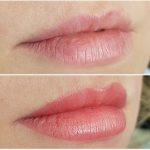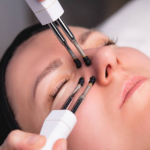Microneedling, a minimally invasive procedure known for stimulating collagen production, has garnered attention for its potential benefits on aging skin. It prompts the question: Is microneedling good for older skin? This article dives deep into the impacts of microneedling on mature skin types, assessing both its benefits and risks, to give you a well-rounded perspective on whether this trendy treatment is suitable for your anti-aging skin care regimen.
The Basics of Microneedling and Its Rise to Prominence

Microneedling, also known as collagen induction therapy, involves using fine needles to create tiny punctures in the top layer of the skin. This controlled skin injury leads to the body’s natural healing process, resulting in increased collagen and elastin production. Initially used for acne scar treatment, microneedling has evolved to become a sought-after procedure for its promise of a rejuvenated complexion. Its popularity is reflected in the growing number of dermatologists and estheticians who include it in their suite of anti-aging services.
Understanding How Microneedling Works on Older Skin

The essence of microneedling’s magic lies in its ability to kickstart the skin’s repair mechanisms. For older skin, this is crucial, as collagen production naturally decreases with age. By creating these micro-injuries, the skin is forced to regenerate, leading to tighter, more youthful skin. This effect can reduce the appearance of wrinkles, which is often the primary concern for mature skin demographics seeking the treatment.
Evaluating the Benefits of Microneedling for Mature Skin
Mature skin can reap multiple rewards from regular microneedling sessions. The benefits are not merely superficial; they are rooted in the procedure’s ability to revitalize skin from within. Here, we list some of the key advantages:
- Improved Skin Texture:
Microneedling can smooth out rough patches and give older skin a softer feel. - Reduction of Fine Lines:
With boosted collagen, fine lines can diminish in appearance, contributing to a more youthful look. - Enhanced Product Absorption:
The small channels created by the needles allow topical treatments to penetrate deeper, making them more effective.
Real Results: Microneedling Success Stories from the Older Demographic
Anecdotal evidence from older individuals who have tried microneedling supports its efficacy. Many report that not only do they see an improvement in their skin’s overall texture and resilience, but friends and family also notice the change. Here’s a snapshot of experiences shared by those who have incorporated microneedling into their skin care routines:
- A 65-year-old woman who saw significant reduction in her fine lines around the eyes and mouth.
- A gentleman in his late 50s who noticed improved firmness and tone of his skin following a series of treatments.
Risks and Considerations When Choosing Microneedling for Senior Skin
Microneedling, a procedure that involves using fine needles to create tiny punctures in the skin, can stimulate collagen production and improve skin texture. However, when considering microneedling for senior skin, there are specific risks and important considerations to keep in mind due to the delicate nature of aging skin. Here are some key points to consider:
- Skin Elasticity:
Senior skin often has decreased elasticity, which might affect the skin’s ability to heal after microneedling, potentially leading to bruising or more prolonged redness. - Sensitivity:
Aging skin can be more sensitive to pain and irritation. Microneedling can cause discomfort during and after treatment, so pain management options should be discussed with a healthcare provider. - Healing Time:
The healing process may be slower in older adults. This can increase the risk of infection and scarring following the procedure. - Pre-existing Skin Conditions:
Conditions like eczema, psoriasis, or rosacea may exacerbate with microneedling. It’s essential to evaluate the skin’s condition and seek a professional opinion before proceeding. - Medications:
Seniors often take medications that can affect the skin’s normal healing process, such as blood thinners. These medications can increase the risk of bleeding and bruising from microneedling.
Professional vs. At-Home Microneedling Treatments
Considering the delicate nature of older skin, professional guidance is highly recommended. However, the rise of at-home devices has made microneedling more accessible. The distinction between professional and at-home treatment outcomes can be vast, and here’s why:
| Aspect | Professional Treatments | At-Home Treatments |
|---|---|---|
| Needle Depth | Adjusted by a trained practitioner to suit individual skin concerns. | Generally shallower, one-size-fits-all approach. |
| Sterilization | Strict sterilization protocols to minimize infection risk. | Depends on user knowledge and practice. |
| Expertise | Professionals can provide immediate intervention if complications arise. | Limited to user’s understanding and experience. |
Integrating Microneedling into Your Anti-Aging Regimen
If you’ve decided to consider microneedling, understanding how to incorporate it into your existing anti-aging regimen is key. From the frequency of treatments to post-procedure care, each aspect holds unique importance when aiming to achieve the best results while maintaining healthy skin.
Older skin might require a less aggressive approach when it comes to treatment frequency. Here’s a general guide to follow:
- Initial treatments might be spaced 4-6 weeks apart to allow for full skin healing and collagen development.
- Maintenance sessions may be scheduled every 6-12 months, depending on individual skin response and goals.
Microneedling vs. Other Anti-Aging Treatments
Microneedling is a popular anti-aging treatment that stands out for its ability to stimulate collagen production, but it’s important to compare it with other methods to determine the best option for individual skin needs. Unlike laser treatments, which use light energy to target deeper layers of skin, microneedling mechanically punctures the skin, initiating a natural healing process that thickens the skin and reduces the appearance of wrinkles and scars.
Chemical peels involve applying a solution to exfoliate the top layers of skin, which can be more aggressive and require longer downtime than microneedling. Meanwhile, dermal fillers provide immediate results by filling in wrinkles or adding volume but do not improve skin texture or elasticity like microneedling. Each treatment has its specific benefits and limitations, and choosing the right one often depends on skin type, desired outcomes, and tolerance for downtime.
The Emerging Trends in Microneedling for Aging Skin
Microneedling, a popular dermatological procedure known for its ability to stimulate collagen production, is evolving with new trends that enhance its effectiveness for aging skin. These developments promise more refined results and potentially less discomfort and downtime. Here are some key trends:
- RF Microneedling:
Combining traditional microneedling with radiofrequency energy, this technique delivers RF energy deep into the dermis, enhancing skin tightening and scar reduction beyond what traditional microneedling can achieve. - PRP Enhancement:
The use of Platelet-Rich Plasma (PRP) in conjunction with microneedling is gaining popularity. PRP involves using a portion of the patient’s own blood, enriched with platelets, to promote healing and cell growth, further enhancing the skin’s rejuvenation process. - At-Home Devices:
The development of safer, user-friendly microneedling devices for home use allows patients to maintain their professional treatment results between sessions. These devices typically use shorter needles and are designed to be less invasive. - Targeted Treatment Serums:
Using customized serums that target specific skin concerns (like hyaluronic acid for hydration or vitamin C for brightening) immediately after microneedling can improve the absorption and efficacy of these products. - Integrated Skincare Systems:
Some clinics now offer comprehensive skincare systems that combine microneedling with other treatments, such as chemical peels or LED light therapy, tailored to the client’s specific aging skin needs.
Conclusion: Should You Consider Microneedling for Your Aging Skin?
The evidence suggests that microneedling can offer significant benefits for older skin, enhancing its appearance and texture. However, it’s imperative for individuals to consider their skin’s unique characteristics and seek professional advice. If you’re seeking a minimally invasive way to rejuvenate your skin, microneedling could be a worthy addition to your anti-aging arsenal.
Frequently Asked Questions
Below, you’ll find answers to some common questions regarding microneedling and its suitability for older skin:
FAQ 1: At what age is it recommended to start microneedling treatments?
While there isn’t a specific age, most experts recommend starting microneedling treatments when signs of aging become noticeable or concerning to the individual, which could be in their 30s, 40s, or beyond.
FAQ 2: How long does it typically take to see results from microneedling on older skin?
Results can vary, however, many people begin to see improvements after a few sessions spaced 4-6 weeks apart. Cumulative effects are generally more noticeable after several months of consistent treatment.
FAQ 3: Can microneedling help with deep wrinkles or only fine lines?
Microneedling is known to improve the appearance of fine lines more effectively. However, it can also contribute to the overall health and plumpness of the skin, which might soften the appearance of deeper wrinkles over time.
FAQ 4: Is there anyone who should avoid microneedling, particularly among older adults?
Individuals with certain skin conditions, such as active acne, rosacea, or eczema, may need to avoid microneedling. Older adults with very thin or fragile skin should consult with a dermatologist before considering the treatment.
FAQ 5: Can microneedling be combined with other anti-aging treatments for older skin?
Yes, microneedling can often be integrated into a comprehensive anti-aging regimen and can be combined with other treatments. It’s important to work with a skincare professional to determine the best treatment plan for your individual needs.


